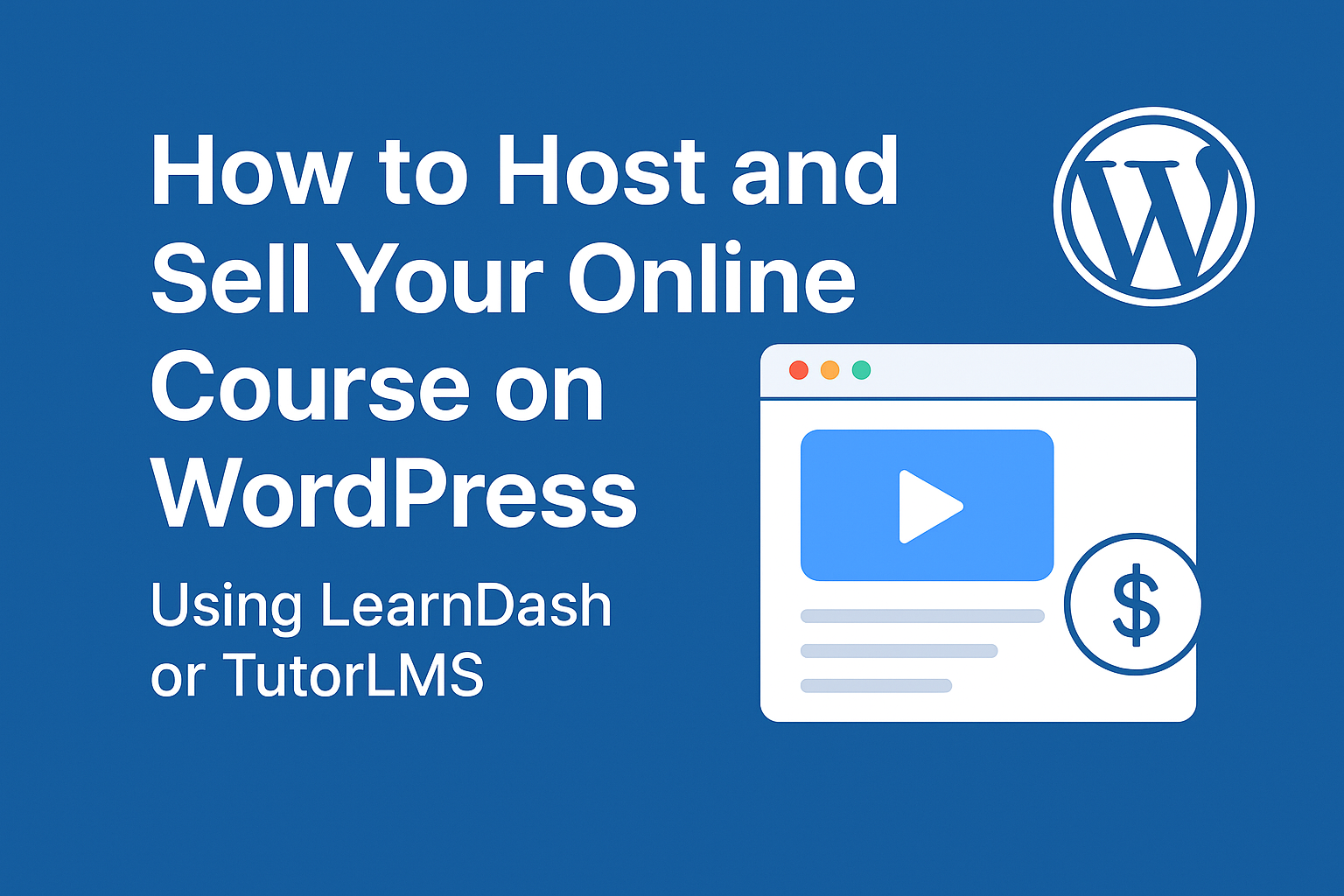How to Host and Sell Your Online Course on WordPress Using LearnDash or TutorLMS (2025 Guide)

How to Host and Sell Your Online Course on WordPress Using LearnDash or TutorLMS (2025 Guide)
A complete, step-by-step playbook for coaches, course creators and entrepreneurs who want full control of their online school — using WordPress + LearnDash or TutorLMS. This guide covers hosting, setup, payments, automation, SEO and proven monetization tactics.
If you're a coach, consultant, or creator, owning your course platform means control, brand consistency, and long-term margins. WordPress + an LMS plugin (LearnDash or TutorLMS) gives you everything a managed platform does — but with far more flexibility. This guide walks you through the full process so you can launch a professional course site in 2025.
Why WordPress is an Ideal Choice for Course Creators
WordPress powers a large portion of the web because it’s flexible, extensible, and inexpensive at scale. For course creators it offers:
- Ownership: you control your content, students and revenue — no vendor lock-in.
- Customization: full control over design, UX, and checkout flows.
- Integrations: connect any CRM, email provider, analytics or payment gateway.
- Scalability: self-hosted options grow as your student base grows.
If you want an authoritative primer on why owning your platform matters, check Google’s own advice on site ownership and best practices in site management (Google SEO Starter Guide).
Step 1 — Choose a Reliable Hosting Provider
Hosting determines speed, reliability and uptime. For course sites that deliver video and files, prefer managed WordPress hosts with strong performance and backups.
- WP Engine — premium performance & caching, ideal for growth.
- Kinsta — great developer tools and fast CDN integration.
- SiteGround — reliable support and solid performance for most creators.
- Budget option: Hostinger or Cloudways (if you’re cost-conscious).
Tip: always enable SSL, use a CDN (Cloudflare or your host's CDN), and set up server-level caching. These steps improve page load and course video delivery.
Step 2 — Pick Your LMS: LearnDash or TutorLMS
Quick comparison:
| Feature | LearnDash | TutorLMS |
|---|---|---|
| Ease of Use | Intermediate — more controls | Beginner-friendly, intuitive UI |
| Course Builder | Drag-and-drop, advanced sequencing | Visual builder, frontend creation |
| Monetization | WooCommerce, built-in carts, subscriptions | Built-in payments + WooCommerce support |
| Integrations | Zapier, GHL, Stripe, LMS ecosystem | Zoom, Elementor, WooCommerce |
Which to choose? LearnDash if you want granular control, advanced reporting, and enterprise features. TutorLMS if you prefer a gentler learning curve and faster setup. Learn more at the official sites: LearnDash · TutorLMS.
Step 3 — Payments, Checkout & Enrollment
Payment flow is a conversion-critical part of your funnel. Both LMS plugins integrate with common gateways:
- Stripe — best for global card payments and subscription billing (stripe.com).
- PayPal — widely trusted and familiar to buyers (paypal.com).
- WooCommerce — use for complex bundles, coupons and multi-product funnels (woocommerce.com).
Pro tip: create a frictionless checkout (one-page when possible), show clear refund policy, and use strong social proof on the checkout page to reduce cart abandonment.
Step 4 — Automate Student Communication & Workflows
Automation keeps students engaged and reduces manual workload. Typical automations include welcome sequences, drip content, reminders and re-engagement campaigns.
Connect your site to a CRM or automation platform:
- Go High Level — great for SMS + multi-channel funnels.
- Keap — excellent for lifecycle automations and payments.
- Mailchimp — solid for email nurturing and audience segmentation.
Automation workflow example:
- Student purchases course → trigger welcome email + SMS
- Day 1: onboarding checklist (video + resources)
- Week 1: progress check-in and encouragement
- At milestone: deliver certificate + upsell offer
Step 5 — Deliver Content That Converts & Retains
How you package your lessons affects completion rates and reviews. Make lessons concise, action-oriented, and trackable.
- Video: Host on Vimeo or an S3 bucket for privacy & performance.
- Downloads: Worksheets, templates, and transcripts increase perceived value.
- Quizzes & assignments: Boost learning and retention.
- Certificates: Offer completion badges to motivate students.
Pro tip: break long modules into short lessons (5–12 minutes) and include a quick action step at the end of each lesson.
Step 6 — SEO & Conversion Optimization
WordPress is inherently SEO-friendly — but you should still follow best practices to drive organic traffic:
- Install Yoast SEO or Rank Math for page-level optimization.
- Optimize course and lesson titles with keywords (e.g., “Online Public Speaking Course for Coaches”).
- Add structured data / schema (Article, Course, FAQ) to your course pages to improve SERP presence (schema.org).
- Publish a blog that targets long-tail search queries and links to your course pages.
Conversion tips: use clear CTAs, show social proof, add urgency (limited seats) and offer a guarantee to reduce friction.
Step 7 — Track What Matters
Data helps you improve. Track key metrics:
- Acquisition: where your traffic is coming from (organic, paid, referrals).
- Conversion: landing page conversion rates and checkout abandonment.
- Engagement: lesson completion rates and quiz results.
- Retention: cohort retention and lifetime value.
Use Google Analytics (GA4), Hotjar for session recordings, and your LMS reports for learner data.
Bundle & Upsell: Boost Average Order Value
Bundling courses with coaching calls or templates increases value and reduces churn. Examples:
- “Course + 3 Coaching Calls” — premium tier
- “Course + Community Access” — recurring subscription
- “Premium Course + Done-for-you templates” — higher price point
Implement bundles with WooCommerce or membership plugins like MemberPress for recurring billing.
Common Pitfalls & How to Avoid Them
- Poor hosting: slow load times kill conversions. Use a managed host.
- No automation: manual onboarding leads to churn — automate emails & SMS.
- Confusing UX: students should find lessons in 1–2 clicks.
- Not tracking data: without analytics you can’t improve.
Ready to Launch Your Course Platform on WordPress?
If you’d like a done-for-you setup — design, LearnDash/TutorLMS integration, payments, automations and SEO — I can build and launch your school so you can focus on teaching. Click below to see packages and get started.
Explore Setup Packages →Want this formatted as a downloadable checklist or a ready-to-publish Elementor template? I can provide a styled Elementor section or a PDF you can use as a lead magnet — just ask.

